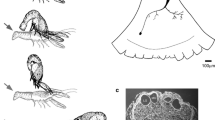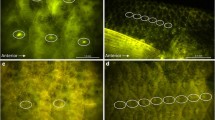Abstract
The turning response to surface waves of clawed toads (Xenopus laevis) with an inactivated lateral line was reinvestigated to examine whether sensory systems other than the lateral line (“second systems”) are involved. Two methods were used to block the lateral line input: selective and reversible inactivation of the lateral line periphery using CoCl2 or chronic destruction with thermocautery. The time-course of the response recovery (response frequency, turning accuracy and reaction time) was recorded. Following CoCl2 inactivation 10 out of 13 animals did not respond to surface waves for at least 2 days. The remaining 3 animals gave sporadic turning responses. It is assumed that in these individuals a “second system” is permanently involved in the detection of surface waves parallel to the lateral line. Five days after the chronic destruction of the lateral line all animals again turned to the centre of surface waves. It is suggested that by this time the “second system” had become capable of substituting for the missing lateral line input. The response frequency and the accuracy of the turning response of lesioned animals varied considerably among individuals but was always lower than in untreated animals (tested up to 120 days).
Similar content being viewed by others
Abbreviations
- LED:
-
light emitting diode
References
Baumann M, Roth A (1986) The Ca++ permeability of the apical membrane in neuromast hair cells. J Comp Phy A 158:681–688
Behnke W (1990) Temporäre und permanente Läsionen im Seitenliniensystem von Xenopus laevis. Diplom Thesis Universität Bielefeld
Claas B, Münz H, Zittlau KE (1989) Directional coding in central parts of the lateral line system. In: Coombs S, Görner P, Münz H (eds) The mechanosensory lateral line. Springer, Berlin Heidelberg New York, pp 409–419
Dijkgraaf S (1947) Über die Reizung des Ferntastsinnes bei Fischen und Amphibien. Experientia 3:206–208
Dowben RM, Rose JE (1953) A metal-filled microelectrode. Science 118:22–24
Elepfandt A (1982) Accuracy of taxis response to water wave localization in the clawed toad (Xenopus laevis). J Comp Physiol A 154:773–780
Elepfandt A (1989) Wave analysis by amphibians. In: Coombs S, Görner P, Münz H (eds) The mechanosensory lateral line. Springer, Berlin Heidelberg New York, pp 527–541
Enger PS, Kalmijn AJ, Sand O (1989) Behavioral investigations on the lateral line and inner ear in predation. In: Coombs S, Görner P, Münz H (eds) The mechanosensory lateral line. Springer, Berlin Heidelberg New York, pp 575–587
Frigge M, Hoagland DC, Iglewicz B (1989) Some implementations of the boxplot. Am Statist 43:50–54
Görner P (1973) The importance of the lateral line system for the perception of surface waves in the clawed toad Xenopus laevis Daudin. Experientia 29:295–296
Görner P (1976) Source localization with labyrinth and lateral line in the clawed toad (Xenopus laevis). In: Schuijf A, Hawkins AD (eds) Sound reception in fish. Elsevier, New York, pp 171–183
Görner P, Mohr C (1989) Stimulus localization in Xenopus: role of directional sensitivity of lateral line stitches. In: Coombs S, Görner P, Münz H (eds) The mechanosensory lateral line. Springer, Berlin Heidelberg New York, pp 543–560
Görner P, Moller P, Weber W (1984) Lateral-line input and Stimulus localization in the African clawed toad Xenopus sp. J Exp Biol 108:315–328
Karlsen HE, Sand O (1987) Selective and reversible blocking of the lateral line in freshwater fish. J Exp Biol 133:249–262
Kramer G (1933) Untersuchungen über die Sinnesleistungen und das Orientierungsverhalten von Xenopus laevis Daud. Zool Jb Physiol Tiere 52:629–676
Rudolph P (1967) Zum Ortungsverhalten von Gyrinus substraticus Steph. (Taumelkäfer). Z Vergl Physiol 50:341–361
Sand O (1975) Effect of different ionic environments on the mechano-sensitivity of the lateral line organs in the mudpuppy. J Comp Physiol 102:27–42
Schanz B, Elepfandt A (1988) Analysis of sound localization by the clawed toad Xenopus laevis. In: Elsner N, Barth FG (eds) Sense organs. Thieme, Stuttgart, p 167
Smith PF, Curthoys IS (1989) Mechanisms of recovery following unilateral labyrinthectomy: a review. Brain Res Rev 14:155–180
Stock C, Münz H, Claas B, Schmitz A (1989) Central processing of the lateral line information in the clawed toad Xenopus laevis. In: Erber J, Menzel R, Pflüger HJ, Todt D (eds) Neural mechanisms of behavior. Thieme, Stuttgart, p 268
Author information
Authors and Affiliations
Rights and permissions
About this article
Cite this article
Claas, B., Münz, H. & Görner, P. Reaction to surface waves by Xenopus laevis Daudin. Are sensory systems other than the lateral line involved?. J Comp Physiol A 172, 759–765 (1993). https://doi.org/10.1007/BF00195401
Accepted:
Issue Date:
DOI: https://doi.org/10.1007/BF00195401




